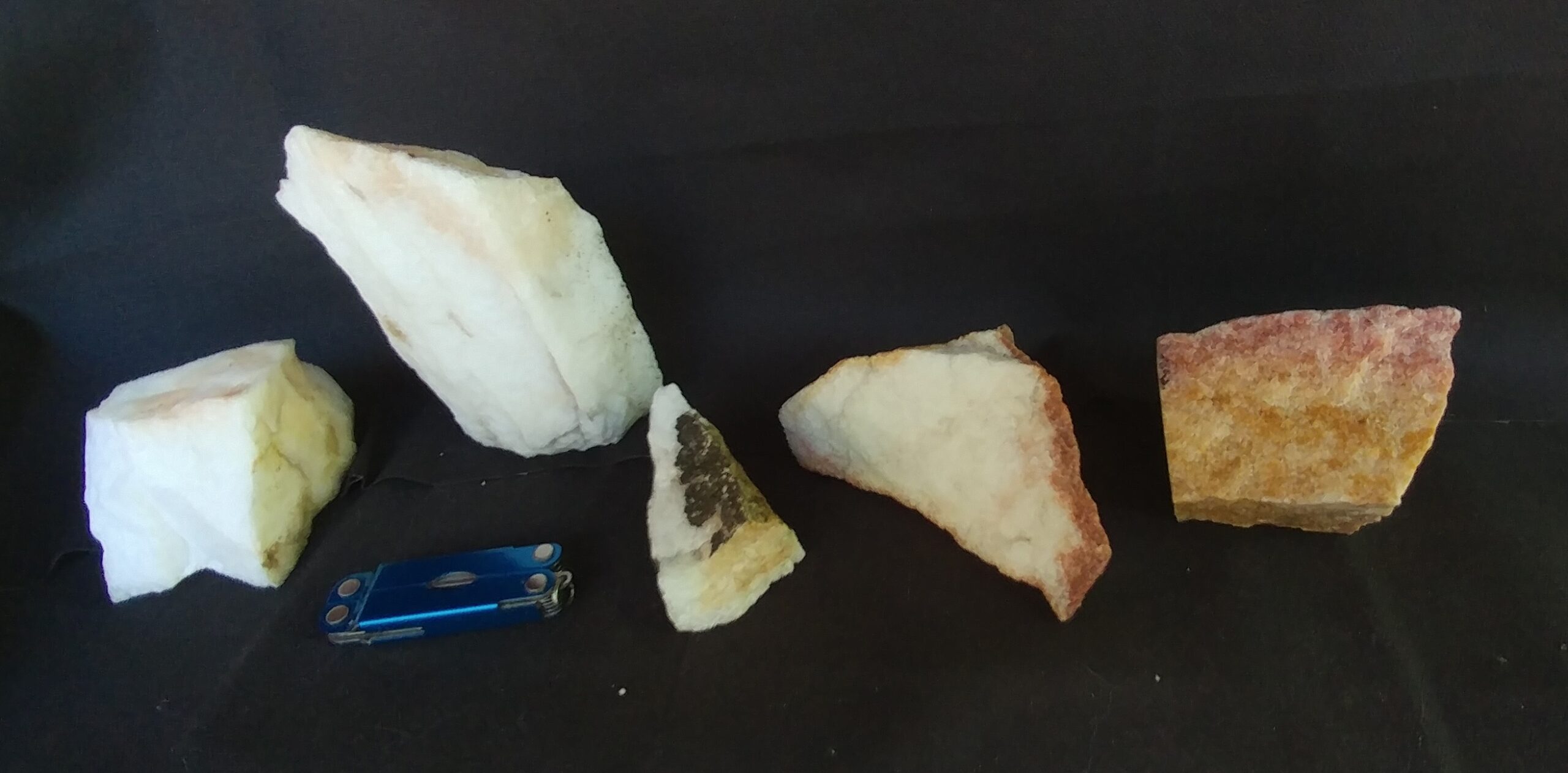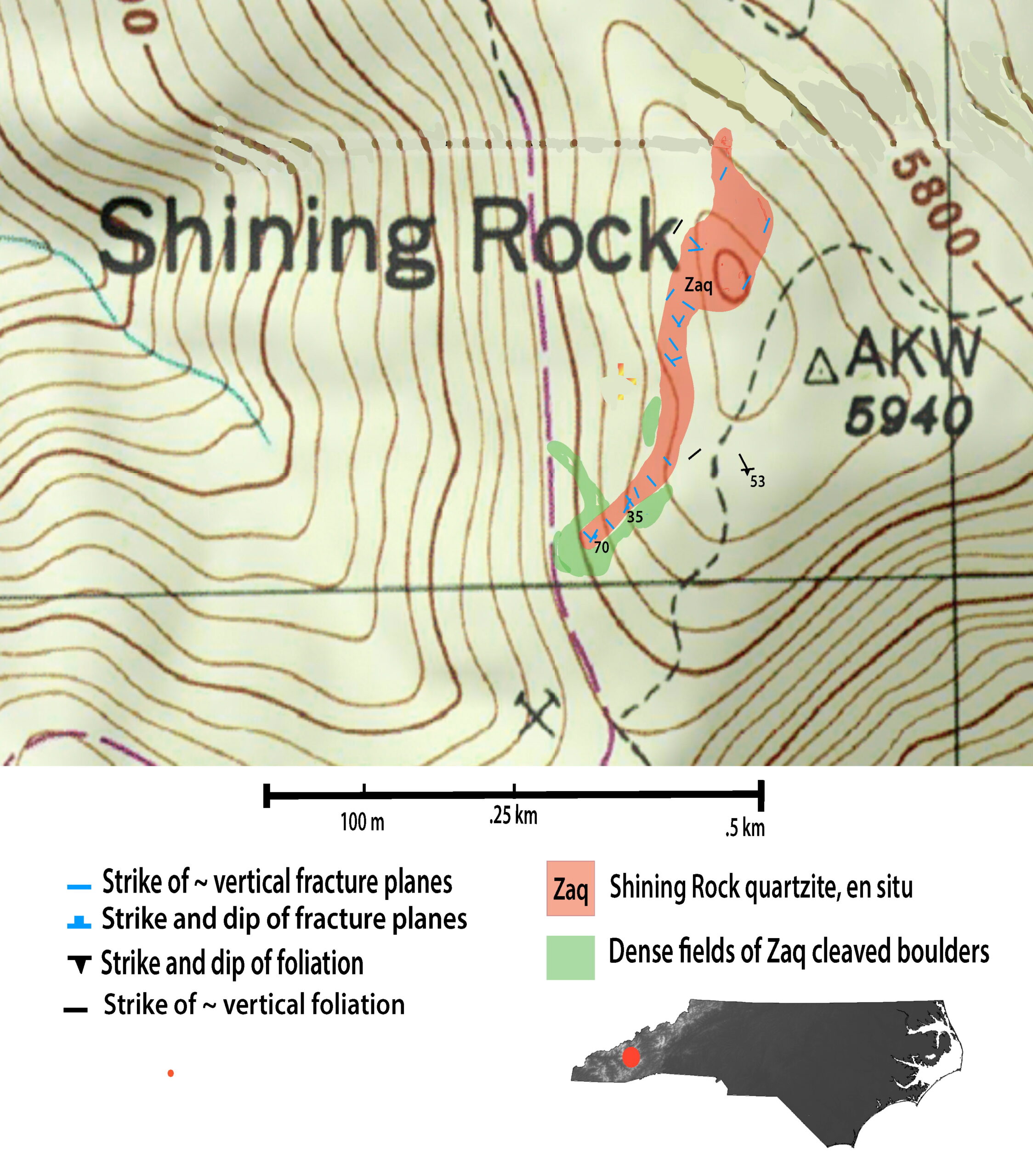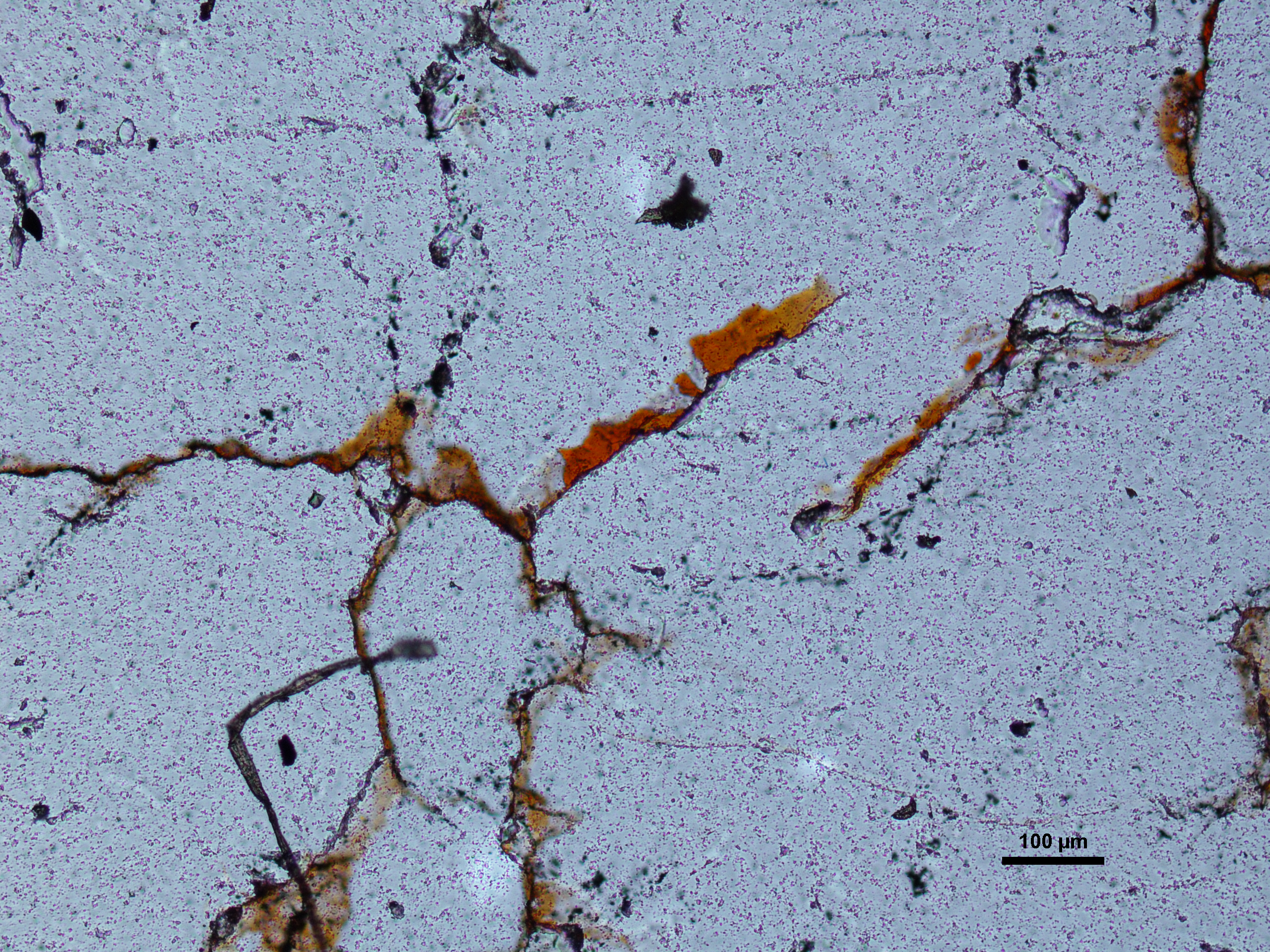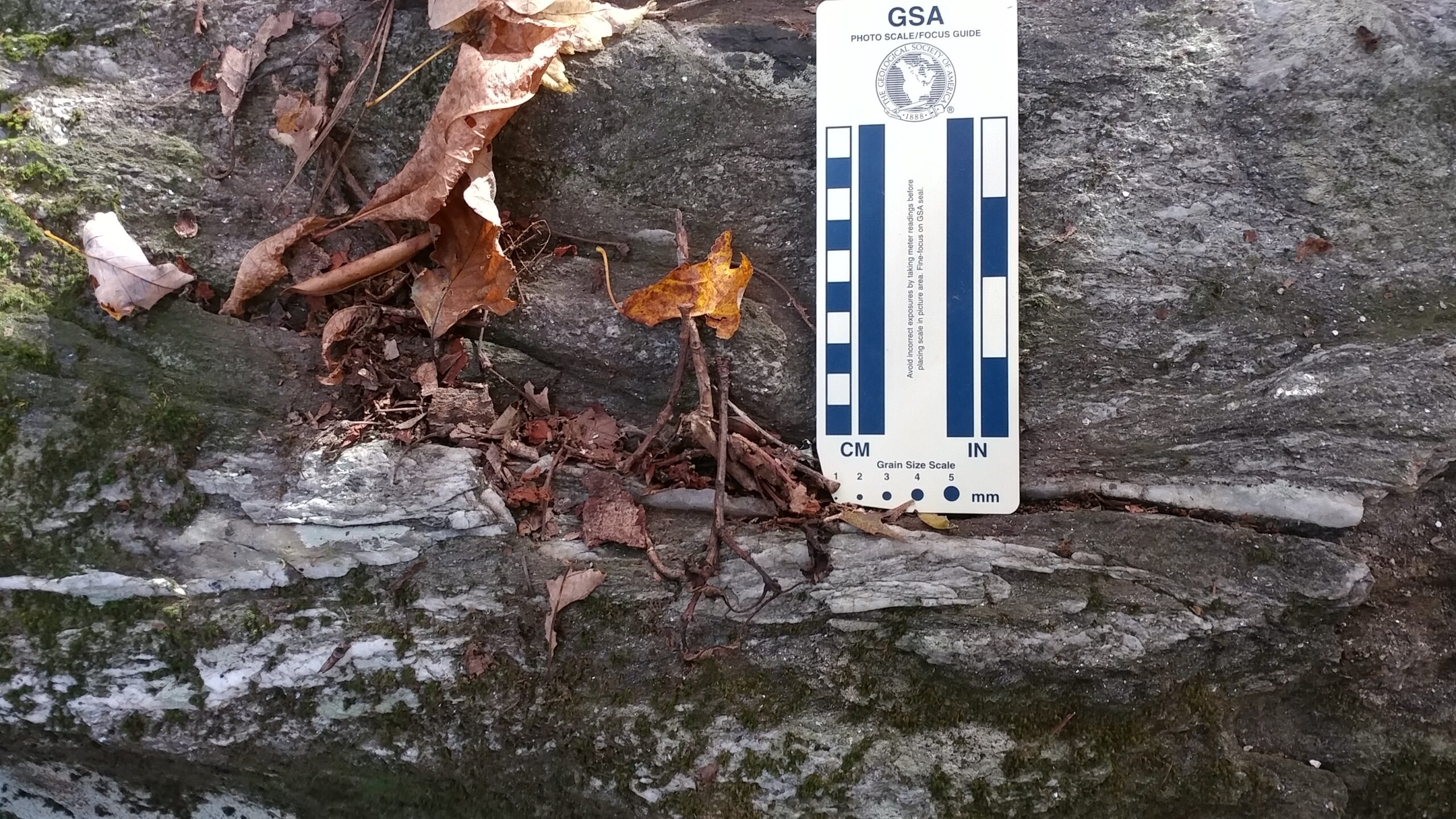From Whence Came Shining Rock?
Report on a Geologic Research Project
Bill Jacobs, December 2020
In 2018, Dr. Brittani D. McNamee and I initiated a research project to examine the unique formation known as Shining Rock, particularly how it was created (“provenance” in Geospeak). Brittani is an Associate Professor in Earth Sciences at UNC Asheville, specializing in mineralogy. Later in the process, we were joined by Dr. Jackie M. Langille, also an Associate Professor in Earth Sciences at UNCA, who specializes in structural geology. After multiple field trips, numerous hours in labs at both UNCA and Appalachian State University, and many hours of back-and-forth observations, hypotheses and refinements (as is characteristic of academic collaborations), as well as some pandemic-related delays, we have completed our project and are in the process of submitting it as a candidate for publication in the journal Southeastern Geology. The purpose of the present article is to summarize our findings and conclusions, but in simpler language than is used in academic journals.

Figure 1. Part of the high exposure of Shining Rock near its southwestern tip. The grey colors are from shadowing and lichen — the underlying rock has the same snowy white coloration as the white patches on the foreground boulder (which had fallen off the main formation).
Why is the Question Interesting?
Shining Rock is a popular hiking destination located off the Blue Ridge Parkway above Graveyard Fields in Haywood County, North Carolina. The quartz outcrop, which gives its name to both the mountain and topo map quadrangle, is large, very pure, and small-grained, a combination that makes it unique in both the Southern Appalachians and the broader geological literature, with the exception of a smaller outcrop located on private land about 10 miles to the northeast in Buncombe County. Because these formations are composed almost totally of quartz, which is very resistant to weathering, exposed surfaces are generally snowy white, but with limited areas of reddish and yellowish staining. Shining Rock extends for about 1,300 feet, stretching across the summit of Shining Rock Mountain. Its height ranges from about 75’ above the surrounding landscape, down to essentially ground level at the Mountain’s summit, with a width ranging from 30 to 150 feet.
Both Shining Rock and the Buncombe outcrop are embedded in the region’s Ashe Metamorphic Suite (“AMS”) bedrock, which was formed about 550 million years ago from various sediments eroding off the predecessor of North America into an earlier version of the Atlantic, known to science as the Iapetus Ocean. As its name suggests, the AMS is a mixed collection of metamorphosed rocks – none of which is close in content or structure to Shining Rock and its mass of similar-sized grains of pure quartz. If Shining Rock was formed at the same time as the highly varied surrounding AMS, how can it be so uniform and pure? On the other hand, if Shining Rock comes to us from a later igneous (molten) intrusion into the AMS “country rock,” we would expect it to be (like numerous smaller veins found throughout the region) a mixture of quartz and feldspar, and to have the wide range of fairly large grain sizes typical of igneous veins that cool slowly underground.
So Shining Rock is an anomaly. And if that alone is not enough to make an interesting question of how it was formed, a better understanding of this unique and beautiful physical feature, which we are privileged to visit and explore, surely is.

Figure 2. Boulders along the top of Shining Rock. Note the patches of reddish/yellowish mineral staining in the otherwise white rock.

Figure 3. Hand samples displaying freshly exposed surfaces. Left to right: (i) from the purer, finer-grained Buncombe formation; (ii) mostly white Shining Rock sample; (iii) white Shining Rock sample with black lichen; (iv) Shining Rock sample with colored rind; (v) yellowish-reddish Shining Rock sample. Pocket knife is 6 cm long for scale.
What We Did
In addition to multiple all-day field trips to examine both Shining Rock and the Buncombe outcrop, we prepared “thin sections” of samples from each location. In the case of Shining Rock, which is within a federal wilderness area, we used samples collected for educational purposes and loaned to us for research by the US Forest Service. In each case, we selected samples from white, reddish and yellowish areas. Thin sections are just that – thin, ground so thin that light comes through them, so they can be microscopically examined. Which we did, with both optical microscopes and high-resolution electron microscopes. Our objectives were to understand the grain structure and composition of the samples. For additional information about the composition of a reddish Shining Rock sample, we ground it to a fine powder and used an “X-Ray diffractometer” to measure its mineral composition. Along the way, we refined the mapping of the overall Shining Rock formation, with particular attention to the direction of its numerous fracture planes and how they related to the orientation of rock layers found in the surrounding AMS.

Figure 4. Shining Rock quartzite mapped on a portion of the NW quadrant of the 1:24,000 USGS topographic map of the Shining Rock, NC quadrangle. Rocks outside the boundaries of the Zaq are mixed metagraywackes, gneisses and schists of the AMS. The map coordinates of Shining Rock Mountain are N35o 22.091’, W82o 51.741’.
What We Found
All of the studied samples confirmed that Shining Rock consists of quartz grains ranging from 0.6 to 1.5 millimeters in diameter (at the Buncombe outcrop, the grains are also quartz, but somewhat smaller, ranging from 0.15 to 0.8 mm). The only non-quartz materials that we found were microscopic quantities of other minerals in the borders between the quartz grains, or occasionally in cracks in the quartz. See Figure 5. This is true even of the colored samples, which differ from the pure white samples only in that the interstitial material is rich in iron, which stains the rock as it oxidizes. Interestingly, even the deep coloration exhibited by some samples arises from minuscule quantities of interstitial iron, a phenomenon we attribute to the purity of the surrounding quartz crystals and the way in which they can transmit and reflect light coming from the small amounts of oxidized iron. See Figure 6. Another observation with respect to the coloration is that it is primarily associated with fracture planes, which would have provided routes for ground water to intrude into the formations, delivering iron-rich material that creeped into the tiny gaps and cracks in the adjoining rock.
Our microscopic examinations also enabled us to estimate the metamorphic history of Shining Rock – that is, what types of temperature and pressure did it experience as it became a very pure version of the tough metamorphic rock known as “quartzite”? Because of the shapes and interlocking nature of the quartz grains, and of the multi-directional shadowing that can be seen when the samples are examined under polarized light (as shown in Figure 5), we concluded that the rock had been subjected to the same high metamorphic conditions experienced by the AMS during its deep burial 450 – 500 million years ago, shortly (on a geologic timescale) after being pushed off the bottom of the Iapetus Ocean. (The shadowing pattern is due to internal optical properties that only occur in highly metamorphosed rocks). This is difficult to explain except by concluding that the quartzite formations were in place within the AMS at least 475 million years ago, during peak metamorphosis of the AMS.
We also found that the fracture planes in Shining Rock align closely with the dominant orientations of layering in the surrounding AMS. This is exactly as would be expected if the quartzite had been in place throughout the several hundred millions of years during which the AMS was pushed out of the Iapetus Ocean and into its present location.
Due to ground cover and pervasive boulder fields, we could not find a clear contact between the quartzite and AMS. We did, however, find one instance at the Buncombe outcrop in which the quartzite and typical AMS schist intermingle in a single boulder, on a scale of inches and in a rather jagged pattern. Figure 7. The appearance is strongly suggestive of interlayering of different sediments along the margins of sand deposits, and does not display the more rounded character that significant igneous intrusions, hot and under pressure, often display along their contacts with country rock.

Figure 5. In this photomicrograph of a Shining Rock thin section, all of the crystals are quartz, regardless of color (which is an artifact of the polarized light being used). The occasional gaps between crystals contain small amounts of non-quartz materials, such as iron and calcium.

Figure 6. Taken in normal light, this photomicrograph shows the uniformity of the main crystals. It also shows other minerals in cracks and grain boundaries, in particular iron-based hematite that, despite its small quantity, has created the staining shown in Figures 2 and 3.

Figure 7. White quartzite and grey AMS schist raggedly interlayered in a boulder at the Buncombe outcrop.
What We Concluded
Everything we found is consistent with Shining Rock and the similar Buncombe formation starting out as sediments in the Iapetus Ocean basin, not as an igneous intrusion into pre-existing sedimentary strata: (i) as previously noted, the narrow range of small grain sizes is not what would be expected from slow cooling of a buried igneous intrusion, nor is the purity of the quartz, with no significant crystals of the feldspar or mica typically found in magma veins; (ii) the quartz crystals are tightly arranged but nonetheless have gaps along grain boundaries, consistent with formation from sand deposits, whereas igneous melts are expected to crystallize more tightly, growing until they run out of room against adjoining crystals (Figure 5); (iii) both the metamorphic history and the orientation of fracture planes indicate that the quartzite has been embedded within the other AMS rocks throughout much of that formation’s geologic history; and (iv) the single example of both quartzite and the more typical AMS bedrock appearing in contact with each other has the appearance of intermingling sedimentary layers (Figure 7).
So, our conclusion is that Shining Rock and the Buncombe outcrop are most likely sedimentary in origin, unlike the more typical igneous-sourced quartz-rich grains found elsewhere in the Southern Appalachians. As such, the quartzite is appropriately viewed as a small, and rare, subunit of the AMS, rather than as a different, and younger, igneous-based formation like the region’s various granitic plutons. But part of the original question remains – how did a rock with such uniform grain sizes and compositional purity form as part of a suite of highly varied and inter-mixed rocks?
Mechanism for Creating Shining Rock
As noted above, the AMS formation presents a variety of rock types, both at map and outcrop scales, a characteristic derived from its history of accumulation of varied sediments in an ocean basin, and mixing by currents, submarine landslides, and the process of transport onto what is now the North American continent. In contrast, the quartzites at both Shining Rock and the Buncombe outcrop are characterized by uniformity of composition and texture. Their sedimentary predecessors (or “protoliths” in Geospeak) would have been a sandstone called quartz arenite, which by definition is at least 90% quartz, and is considered to be very “mature,” that is, worked by forces of erosion and decomposition over a long period of time until most of the non-quartz materials have been removed. But how would such a mature protolith have formed within the AMS?
We hypothesize that the formation of the quartz arenite protoliths, within the otherwise varied AMS, was the result of an unusual, but feasible, combination of factors. Sedimentary geologists have long recognized the ability of shallow tidal waters to produce mature quartz sands. Quartz is the natural residual material as sediments weather and abrade – the less durable and more reactive feldspars, micas and carbonate materials are more readily reduced to silt-sized particles and washed away or dissolved in ocean waters. Production of mature quartz sands is enhanced in tropical conditions (as would have been prevalent during the time that the AMS sediments were accumulating), and by extended exposure to weathering and tidal action along generally low-lying coast lines of the type believed to have bordered the Iapetus Ocean. With a favorable arrangement of tides, barrier islands, and shoreline and river drainage configurations, the resulting quartz grains can be isolated and accumulated without significant mixing with other materials. In this way, beaches of almost pure quartz can be assembled, as is illustrated at various locations in the modern world.
In evaluating this possibility, we reviewed a collection of sands maintained for research purposes by UNC Asheville. We found samples from at least one beach (Destin, Florida), and possibly two others (Fort Walton and Okaloosa, Florida), whose quartz sands are of a purity consistent with the hypothesized quartz arenite protolith of Shining Rock and the Buncombe outcrop. Another half dozen samples from beaches in Florida and south Georgia are close to pure quartz, with very minor but noticeable incidence of dark minerals. The grain sizes of the sampled beach sands are within narrow ranges, typically up to 0.5 mm; this is somewhat smaller than the typical Shining Rock quartz grain, a phenomenon that can be explained by different sorting dynamics and by crystal growth during metamorphosis into today’s Shining Rock quartzite.
Although the modern beach examples suggest further accumulation mechanisms are unnecessary, it is also possible that windborne processes were involved. Winds are highly effective at sorting deposits into the narrow ranges of grain size and weight found in both of the quartzites and particularly in the Buncombe outcrop.
Once accumulated, it was necessary for the quartz sands to be buried sufficiently to be cemented together and become rock (“lithification”), without significant mixing in the process. An explanatory hypothesis would be a rise in sea levels and a pulse of heavier river-borne sedimentation, but in the context of a sheltered coastal environment that protected the sands, already densely packed by shoreline moisture, from significant mixing as they were buried under the newer sediments. After burial and lithification as a highly mature quartz arenite, the protoliths, along with other rocks that became the AMS formation, would have been transported onto the adjoining landmass, and eventually into their present locations. They also would have been buried to depths sufficient for the high level of metamorphism that recrystallized the quartz grains, turning quartz arenite (a sedimentary sandstone) into today’s quartzite.
So, when visiting Shining Rock, you can think of it as the fossil of an ancient, brilliantly white, tropical beach. Or perhaps of a nearby sand dune. But forget about the swaying palms – those didn’t come along for another 250 million years or so.
